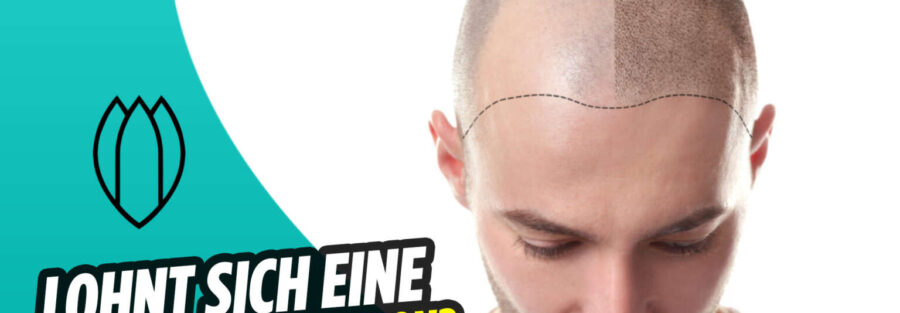YOU CAN COUNTERACT BALDNESS WITH HAIR TRANSPLANTATION?
Hair transplantation is a very popular procedure, especially among men. In some men, hereditary receding hairlines appear at an early age and become more pronounced over time. Baldness on the top of the head can also become noticeable at a young age. With advancing age, men with formerly thick head hair are also increasingly afflicted by the problem. The hair becomes thinner, bald patches on the top of the head or even full bald patches develop. Hair transplantation can make men feel young and attractive again. After all, the appearance is often conducive to personal success. Professionally and privately, men with a full head of hair are equated with strength and power by those around them.
This is neither ill will nor prejudice. It is simply in the nature of man to pick the strongest partner and this is just rather young and strong. Of course, one's own self-esteem also plays a role, because everyone wants to look attractive for themselves.
DOES HAIR TRANSPLANTATION HELP WITH HAIR LOSS?
Hair loss and similar problems do not have to bother the modern man in most cases. They can be eliminated with great probability by hair transplantation. Many hair loss remedies are not even proven in their effectiveness and others have to be used for life in order to maintain the splendor of hair. Transplantation is a permanent and promising solution. Especially in patients with androgenetic hair loss, skin transplantation is effective.
In this form of hair loss, the hair, respectively the roots react to male sex hormones, shrink, become weak and the result is hair loss. In case of hair loss due to disease or other hormonal disorders, even transplanted hair could fall out again. Accordingly, it is important to clarify the causes exactly and possibly counteract them with medication.
REASONS FOR A HAIR TRANSPLANT
One's own body image and the desire for more attractiveness are understandable and a good reason for a hair transplant. But not only age, hair loss or hormonal problems cause bald spots on the head. Scarred or otherwise injured areas after accidents or surgeries also make for unsightly head areas. Inflammations and burns also leave large or small problem areas in the middle of the head. These problems can also usually be corrected by hair transplantation.
THE PROCEDURE OF A HAIR TRANSPLANT
Anyone who decides to have a hair transplant, of course, wants to know exactly how it will happen and what to expect. First of all, it is important to know that it is always the patient's own hair, which is taken from another part of the head. It is then transplanted to the thinning or balding parts of the head. Of course, you need enough of your own hair, which can be used. However, this hair does not necessarily come from the head. After all, this should remain as densely hairy as possible.
In some cases, hair is taken from the crown of the back of the head. These are simply transplanted to another part of the head, but this creates gaps in the head hair. However, many other parts of the male body also have hair that can be used. When using these hairs, attention must of course be paid to their condition. Not all hairs are suitable for the procedure, because they should match the existing hair and complement it as inconspicuously as possible. A natural appearance is important. Chest hair, leg hair or other body hair is often used.
Now follows first of all the local anesthesia under which the hair transplantation is performed. Either small strips of hair are now removed or the surgeon removes individual groups of hair. If the hair is removed as a group, the hair roots are first loosened. Using precision instruments that allow for careful removal, the specialist carefully works on each individual hair. The hairs are now temporarily stored in a special solution. The nutrient solution ensures that everything remains fresh, is not damaged or dries out, because the hairs to be transplanted are extremely sensitive.
High magnification magnifying glasses and also microscopes are also used in hair transplantation. Now, openings are created by hand in the scalp, which are intended for the grafts. These are created in an irregular and so natural pattern. This technique provides a coherent appearance and ensures a natural look of the operated areas. The hair is now inserted into the openings.
HOW LONG DOES THE HAIR TRANSPLANT TAKE?
The duration of hair transplantation and the number of required repetitions vary greatly. If it is a small area, one visit to the surgeon is sufficient. Two hours are needed for a small session for transplanting a few hairs. A long hair transplant, on the other hand, takes up to eight hours. If a lot of hair is transplanted, the patient will have to visit several times. This is also important to give the affected areas a little rest.
WHAT HAPPENS AFTER THAT?
Following the hair transplantation, a recovery period must also be observed. Sauna sessions, tanning in solarium and under the sun or strenuous sports should be avoided for two or three days. Swimming in salty sea water and also in chlorinated swimming pools are possible after four weeks at the earliest. In the best case, however, should become something. Depending on the field of activity, work should also be paused. For some activities this is even necessary up to a week. Washing the hair should be done either carefully with water or with a very gentle baby shampoo.
Slight crusting, redness, swelling or moderate pain may occur, but quickly subside. The new hairs are initially not very strong and may fall out again, but with time the transplanted hairs grow just like the rest of the hair and can be treated as such from this point on.
WHAT TO DO FOR BALDNESS?
In case of baldness, it is of course not possible to remove and transplant your own hair from the head. Even with large areas that require hair transplantation, there is accordingly not enough head hair available for transplantation. At this point creativity is required. It is not always possible to successfully treat a full bald head or an advanced bald head.
Of course, the more hair is left on the head, the greater the chances of success. However, numerous, excellent results have been achieved in the past with hair transplantation for baldness. However, a consultation with a well-trained and specialized specialist will quickly bring clarity and, in many cases, relief. Hair from the extremities, abdomen and back, as well as from the pubic area or armpits can be used here. This is to be discussed individually with the treating specialist.
Birgül Polatli




